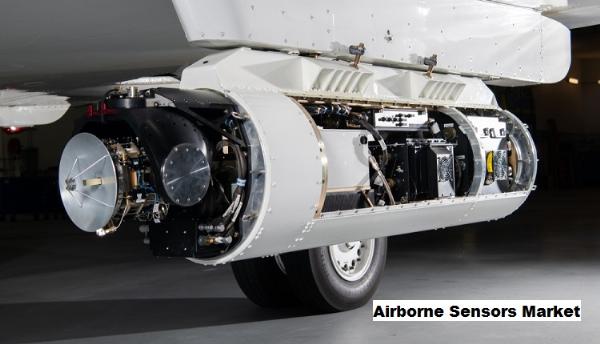Airborne Sensors market Driven By Rising Demand in Unmanned Aerial Vehicles (UAVs)

Strong 8k brings an ultra-HD IPTV experience to your living room and your pocket.
Surge in Unmanned Aerial Vehicles (UAVs) demand and the escalating requirement for environmental monitoring and climate research are factors driving the Global Airborne Sensors market in the forecast period 2025-2029.
According to TechSci Research report, “Airborne Sensors Market - Global Industry Size, Share, Trends, Competition Forecast & Opportunities, 2029”, the Global Airborne Sensors Market stood at USD 9.2 billion in 2023 and is anticipated to grow with a CAGR of 6.90% in the forecast period, 2025-2029. The global airborne sensors market is a crucial component of the aerospace and defense industry, playing a pivotal role in various applications ranging from military surveillance to environmental monitoring and disaster management. As technological advancements continue to drive innovation, the airborne sensors market has witnessed significant growth and evolution in recent years.
One of the primary drivers propelling the growth of the airborne sensors market is the increasing demand for unmanned aerial vehicles (UAVs) or drones across both military and commercial sectors. UAVs equipped with sophisticated sensors enable real-time data collection, intelligence gathering, and surveillance, making them indispensable assets for defense and security agencies worldwide. Moreover, the growing adoption of UAVs in civil applications such as agriculture, infrastructure inspection, and disaster response further fuels the demand for airborne sensors.
Advancements in sensor technology, including the development of lightweight and compact sensors with enhanced capabilities, have expanded the scope of airborne surveillance and reconnaissance missions. These sensors encompass a wide range of technologies, including electro-optical/infrared (EO/IR), synthetic aperture radar (SAR), hyperspectral imaging, LiDAR (Light Detection and Ranging), and multispectral imaging, among others. Such sensors enable precise detection, identification, and tracking of targets or objects of interest, enhancing situational awareness and mission effectiveness.
In addition to military and civil applications, the airborne sensors market is witnessing growing opportunities in environmental monitoring, climate research, and disaster management. Airborne remote sensing platforms equipped with specialized sensors play a vital role in monitoring environmental parameters, detecting natural disasters such as wildfires, floods, and hurricanes, and assessing their impact. These sensors provide valuable data for scientific research, resource management, and decision-making processes aimed at mitigating environmental risks and enhancing resilience.
The increasing focus on border security, maritime surveillance, and counter-terrorism efforts drives the demand for airborne sensor systems capable of monitoring vast areas and detecting potential threats in real-time. Integrated sensor suites, including electro-optical, infrared, and radar sensors, enable comprehensive surveillance capabilities, enabling defense and security agencies to enhance border protection and maritime domain awareness.
The commercial aviation sector also contributes to the growth of the airborne sensors market, particularly in the context of aircraft health monitoring and maintenance. Advanced sensor systems installed onboard commercial aircraft enable continuous monitoring of various parameters such as engine performance, structural integrity, and component health, facilitating predictive maintenance and reducing downtime. These sensors play a crucial role in ensuring the safety, reliability, and efficiency of commercial air transportation.
However, the airborne sensors market faces challenges such as regulatory hurdles, privacy concerns, and interoperability issues, particularly in the context of cross-border operations and data sharing. Additionally, cybersecurity threats pose a significant risk to airborne sensor systems, emphasizing the need for robust cybersecurity measures to safeguard sensitive data and ensure mission integrity.
Browse over XX market data Figures spread through XX Pages and an in-depth TOC on "Global Airborne Sensors Market”
https://www.techsciresearch.com/report/airborne-sensors-market/22482.html
North America is a significant player in the global airborne sensors market, driven by the presence of leading aerospace and defense companies, as well as robust investments in research and development. The region benefits from a strong military presence, which drives demand for advanced sensor technologies for surveillance, reconnaissance, and intelligence gathering purposes. Additionally, the growing adoption of unmanned aerial vehicles (UAVs) for both military and commercial applications further fuels the demand for airborne sensors in this region.
Europe is another prominent market for airborne sensors, with countries like the UK, France, and Germany leading the way in defense spending and technological innovation. The region hosts several key players in the aerospace and defense sector, contributing to the development of cutting-edge sensor technologies. Moreover, increasing investments in border security and surveillance systems drive the demand for airborne sensors across Europe. In the CIS (Commonwealth of Independent States) region, defense modernization efforts and geopolitical tensions stimulate the procurement of advanced airborne sensor systems.
The Asia-Pacific region is witnessing rapid growth in the airborne sensors market, fueled by rising defense budgets, territorial disputes, and the modernization of military capabilities. Countries like China, India, Japan, and South Korea are investing heavily in defense infrastructure and indigenous development of sensor technologies. Additionally, the growing commercial application of UAVs for tasks such as agriculture, infrastructure monitoring, and disaster management contributes to the expansion of the airborne sensors market in the region.
The Middle East & Africa region represents a growing market for airborne sensors, primarily driven by security concerns, regional conflicts, and counter-terrorism efforts. Countries in the Middle East, such as Saudi Arabia, UAE, and Israel, are major buyers of advanced military equipment, including airborne sensor systems, to bolster their defense capabilities. Moreover, the need for surveillance and reconnaissance in remote and hostile environments drives the adoption of unmanned aerial systems equipped with sophisticated sensor payloads.
South America exhibits moderate growth in the airborne sensors market, with countries like Brazil, Argentina, and Chile investing in defense modernization programs and border surveillance systems. The region's vast territorial expanse and diverse geographic features necessitate the use of airborne sensors for monitoring and security purposes. Furthermore, increasing commercial applications of UAVs in industries such as agriculture, mining, and environmental monitoring contribute to the demand for airborne sensor technologies in South America.
Major companies operating in Global Airborne Sensors Market are:
HEXAGON AB
Thales Group
RTX Corporation
Lockheed Martin Corporation
Information Systems Laboratories (ISL)
Teledyne Optech
General Dynamics Corporation
Honeywell International Inc
ITT INC
AVT Airborne Sensing GmbH
Download Free Sample Report
https://www.techsciresearch.com/sample-report.aspx?cid=22482
Customers can also request for 10% free customization on this report
“The global airborne sensors market is a dynamic sector within the aerospace and defense industry, fueled by the escalating demand for advanced situational awareness and data collection capabilities across military, commercial, and scientific applications. Innovations in miniaturization, high-resolution imaging, and the integration of artificial intelligence drive the market's evolution. As airborne platforms, including UAVs and commercial aircraft, play increasingly vital roles, the market's growth is propelled by technological trends that enhance surveillance, reconnaissance, and environmental monitoring capabilities.
However, challenges such as complexity, cybersecurity, and regulatory compliance require strategic solutions. Despite these hurdles, the global airborne sensors market remains a critical enabler of intelligence and operational effectiveness in diverse aerial endeavors.” said Mr. Karan Chechi, Research Director with TechSci Research, a research-based management consulting firm.
“Airborne Sensors Market– Global Industry Size, Share, Trends, Opportunity, and Forecast, Segmented By Type (Non-Scanning, Scanning), By Application (Defense Aircraft, Commercial Aircraft, Others), By Region, Competition, 2019-2029”, has evaluated the future growth potential of Global Airborne Sensors Market and provides statistics & information on market size, structure and future market growth. The report intends to provide cutting-edge market intelligence and help decision makers take sound investment decisions. Besides, the report also identifies and analyzes the emerging trends along with essential drivers, challenges, and opportunities in Global Airborne Sensors Market.
Contact Us-
TechSci Research LLC
420 Lexington Avenue, Suite 300,
New York, United States- 10170
M: +13322586602
Website: www.techsciresearch.com
Note: IndiBlogHub features both user-submitted and editorial content. We do not verify third-party contributions. Read our Disclaimer and Privacy Policyfor details.


